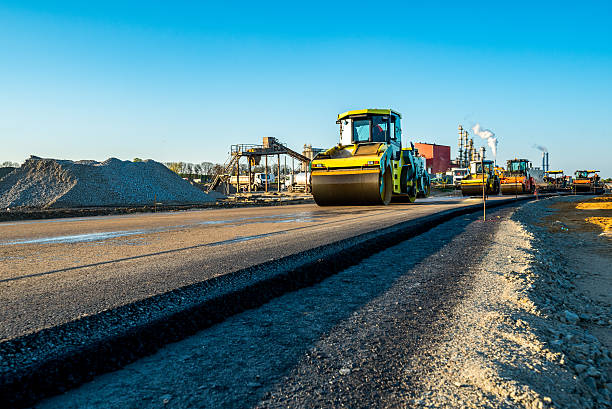Contact Us
RoadVision AI
Private Limited
Office No. 308 & 310, B Block
Ansal Chamber - 1, Bhikaji Cama Place,
Near Engineers India Limited (EIL) Bhawan, New Delhi - 110066
© 2024 | RoadVision AI | All rights reserved
Stone Matrix Asphalt (SMA) is a highly durable, rut-resistant bituminous mix used for heavy traffic roads. It was first developed in Germany in the 1960s and later adopted worldwide, including India, for pavement surfacing and intermediate courses. The Indian Roads Congress (IRC) introduced IRC:SP:79-2008, which provides tentative specifications for SMA suited to Indian conditions.
In this blog, we will explore the materials, design process, construction techniques, and quality control aspects of IRC:SP:79-2008 and how it ensures the longevity and performance of bituminous roads.

The IRC:SP:79-2008 manual sets specifications for Stone Matrix Asphalt (SMA) as a high-performance gap-graded bituminous mix designed to resist rutting, cracking, and water damage. Unlike conventional bituminous mixes, SMA relies on a stone-on-stone aggregate skeleton that enhances its stability and load-bearing capacity.
✅ Superior Rut Resistance: Designed for high-traffic roads
✅ Increased Durability: Prevents fatigue cracking and moisture damage
✅ High Skid Resistance: Improves road safety in wet conditions
✅ Longer Service Life: Reduces maintenance costs
✅ High Binder Content: Improves flexibility and resistance to aging
According to the IRC guidelines, SMA is recommended for:
✔ Heavy traffic roads as a wearing course or binder course
✔ Highways, expressways, and urban arterial roads
✔ Areas with extreme weather conditions (hot summers and heavy rainfall)
✔ Airport runways and taxiways requiring high durability
✔ Two Types of SMA Mixes:
The bitumen used in SMA should conform to IS:73 or IRC:SP:53 standards. The viscosity-graded (VG) paving bitumen or Polymer Modified Bitumen (PMB) is recommended based on climatic conditions.
✔ Bitumen Type:
✔ Crushed stone retained on a 2.36mm sieve
✔ Cubical, strong, and durable particles
✔ Aggregate Impact Value: ≤ 18%
✔ Los Angeles Abrasion Value: ≤ 25%
✔ Water Absorption: ≤ 2%
✔ 100% crushed sand (manufactured sand)
✔ Non-plastic with Sand Equivalent Test value ≥ 50
✔ Stone dust and/or hydrated lime
✔ Plasticity Index ≤ 4
✔ Fly ash is not permitted in SMA
✔ Pelletized cellulose fibers are added to prevent binder draindown
✔ Minimum dosage: 0.3% of total mix weight
The SMA mix design follows the AASHTO MP8 & PP41 standards, ensuring an optimal balance of stability, voids, and durability.
✔ Air Voids: 4.0%
✔ Minimum Binder Content: 5.8%
✔ Voids in Mineral Aggregate (VMA): ≥ 17%
✔ Voids in Coarse Aggregate (VCA): Ensures stone-on-stone contact
🚫 SMA should not be laid when:
✔ The existing bituminous surface must be clean and dry
✔ Potholes and cracks must be repaired
✔ Tack Coat Application:
✔ SMA mix is prepared in a hot mix plant
✔ Bitumen temperature: 150-165°C (VG-30), 160-180°C (PMB-40)
✔ Mix is transported in insulated trucks to prevent cooling
✔ Rolling must begin immediately after laying
✔ Compaction must be completed before temperature drops below 100°C
✔ Rollers Used:
✔ Minimum compacted density: 94% of theoretical max specific gravity
To ensure durability and long-term performance, strict quality control measures are followed:
✔ Surface Smoothness: Variation ≤ 6mm under a 3m straight edge
✔ Air Voids in Mix: Must be 4.0% ± 0.5%
✔ Binder Content: 5.8% minimum
✔ Moisture Susceptibility (TSR): ≥ 85%
✔ Density of Compacted Layer: ≥ 94% of max theoretical density
✅ Superior Strength: Ideal for high-traffic roads
✅ Longer Life Span: Reduces maintenance costs
✅ Better Skid Resistance: Enhances road safety
✅ Resistant to Rutting & Fatigue Cracking
✅ Effective for Harsh Weather Conditions
The IRC:SP:79-2008 code provides clear guidelines for designing, constructing, and maintaining Stone Matrix Asphalt (SMA) roads in India. By following proper mix design, material selection, and quality control measures, SMA offers superior durability, reduced maintenance costs, and enhanced road performance. For high-traffic highways and expressways, Stone Matrix Asphalt (SMA) is an ideal long-term solution to withstand heavy loads, extreme weather, and continuous wear and tear.
RoadVision AI is revolutionizing road infrastructure development and maintenance with its innovative solutions powered by computer vision AI. By leveraging advanced technologies, the platform conducts comprehensive road condition monitoring and traffic surveys, enabling early detection of surface issues like potholes and cracks for timely repairs and enhanced roads. Through traffic congestion analysis, RoadVision AI provides data-driven insights to address traffic congestion challenges and optimize road usage. With a focus on building smarter and more efficient road infrastructure, RoadVision AI ensures full compliance with IRC Codes, helping engineers and stakeholders reduce costs, minimize risks, and improve road safety and transportation efficiency.